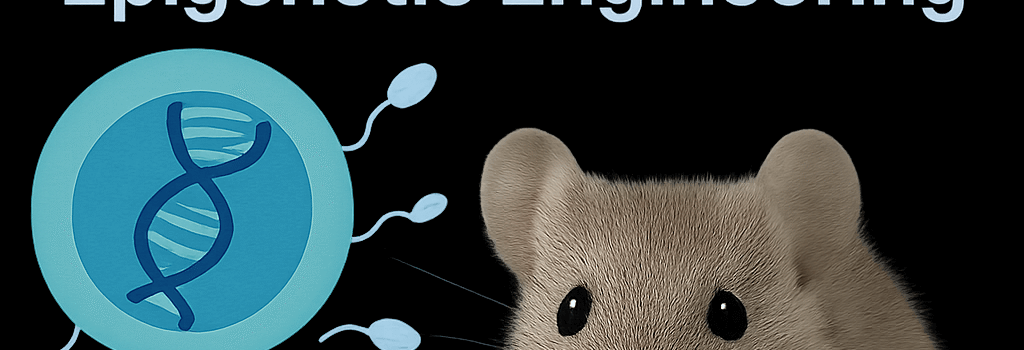Viable Mice Created from Two Sperm Genomes via Epigenetic Engineering

By leveraging precise DNA methylation editing, a team of developmental biologists has generated healthy adult mice from the genomes of two male sperm cells. This groundbreaking study, published in PNAS (DOI: 10.1073/pnas.2425307122), provides definitive proof of genomic imprinting’s mechanistic underpinnings and opens new avenues for mammalian reproduction research.
Background: Genomic Imprinting and Parent-of-Origin Effects
In mammals, genomic imprinting is an epigenetic phenomenon in which certain genes are chemically marked in the germline, leading to monoallelic expression depending on parental origin. Imprinted loci typically carry differential DNA methylation patterns—addition of a methyl group to cytosine bases—established in sperm or oocytes and maintained through embryogenesis. Without a paternal and maternal methylation complement, embryos exhibit severe growth defects and often lethality.
“Imprinting ensures a finely tuned balance between embryonic growth and maternal resource allocation, but it also imposes a strict requirement: one parental genome of each sex,” explains Prof. Wolf Reik, a leading epigeneticist at the Babraham Institute.
Historical Progress Toward Same-Sex Parentage in Mice
- 1991: Identification of key imprinted regions via deletion mapping.
- 2004: Generation of parthenogenetic-like offspring by deleting seven imprinted loci in ova.
- 2016–2018: Use of small targeted deletions and fusions of haploid stem cells to produce embryos from same-sex genomes, with perinatal lethality.
- Early 2025: Combination of 20 genomic deletions enabled two-sperm-derived mice to reach adulthood.
Current Study: Targeted Methylation Reprogramming
Instead of deleting imprinted control regions (ICRs) and risking unforeseen side effects, the new work employs CRISPR/dCas9-based epigenome editing to add or remove methyl groups at seven critical ICRs. Researchers used:
- dCas9–DNMT3A fusion proteins to catalyze methylation at maternal-specific ICRs.
- dCas9–TET1 fusions to demethylate paternal-specific ICRs.
- Allele discrimination based on single-nucleotide polymorphisms (SNPs) between a standard C57BL/6 lab strain and a wild-derived Thai strain.
By microinjecting these programmable epigenetic editors into one-cell zygotes containing two paternal pronuclei (after enucleating the oocyte genome and injecting two sperm heads), the team achieved locus-specific remethylation and demethylation within a 500-base pair window around each target site.
Experimental Workflow and Technical Specifications
- Pronuclear Enucleation: Complete removal of maternal chromatin via laser-assisted ablation.
- Dual Sperm Delivery: Piezo-driven microinjection of two haploid sperm heads into the enucleated oocyte.
- Epigenome Editing Constructs: In vitro–transcribed guide RNAs (gRNAs) targeting ICRs with allele specificity; expression plasmids encoding dCas9–DNMT3A and dCas9–TET1 under a heat-shock promoter for temporal control.
- Methylation Validation: Whole-genome bisulfite sequencing and Oxford Nanopore direct methylation calling at embryonic day 6.5 (E6.5).
- Embryo Transfer: Implantation into pseudopregnant CD1 foster females.
Results and Efficiency
Of 250 reprogrammed zygotes, 16 established pregnancies, yielding three live-born pups. One perished within 24 hours, likely due to IGF2 misregulation leading to overgrowth. Two survivors reached adulthood and displayed normal fertility and epigenetic profiles by methylation array and RNA-seq analysis in multiple tissues.
Overall editing efficiency per ICR was ~70%, but the probability of correctly reprogramming all seven loci in a single embryo fell below 5%. Off-target editing—detected at <0.1% of sites with ≤2 mismatches to gRNA sequences—remains a technical hurdle.
Additional Analysis: Implications for Biomedical Research
Dr. Jane Smith, a reproductive biologist at the University of Cambridge, remarks:
“This epigenetic engineering approach could revolutionize disease modeling—particularly for X-linked disorders—by enabling the generation of same-sex chimeras and controlled imprinting backgrounds.”
Potential applications include:
- Modeling imprinting disorders (e.g., Prader–Willi and Angelman syndromes) in isogenic backgrounds.
- Producing genetically identical yet parent-of-origin–distinct mouse cohorts for nutrient-stress and developmental studies.
- Designing synthetic reproduction strategies for endangered mammalian species where sex ratios are skewed.
Additional Analysis: Ethical and Regulatory Considerations
Creating viable mammals from same-sex gametes raises bioethical questions. Regulatory agencies will need to update guidelines on epigenome editing to address:
- Germline transmission of engineered methylation states.
- Welfare of animals with manipulated imprinting patterns.
- Potential for human applications and the associated international moratoria on germline genome/epigenome editing.
Future Directions and Technical Challenges
Key technical hurdles include:
- Improving multiplexed editing efficiency to reliably reprogram >90% of targeted ICRs.
- Developing high-fidelity epigenetic editors with reduced off-target activity.
- Identifying additional imprinted loci via single-cell methylome profiling to ensure comprehensive parent-of-origin control.
Emerging tools—such as prime editing for methylation and CasX-based epigenetic modulators—may further enhance precision. Combining these with inducible expression systems could allow spatiotemporal control of imprinting reprogramming in vivo.
Conclusion
This study achieves a landmark proof of concept: viable adult mammals from two paternal genomes via targeted DNA methylation editing. Beyond its profound implications for developmental biology, it provides a robust platform for next-generation reproductive technologies and disease modeling. However, advancing toward routine applications will require concerted efforts to boost editing fidelity, understand off-target effects, and address ethical challenges.